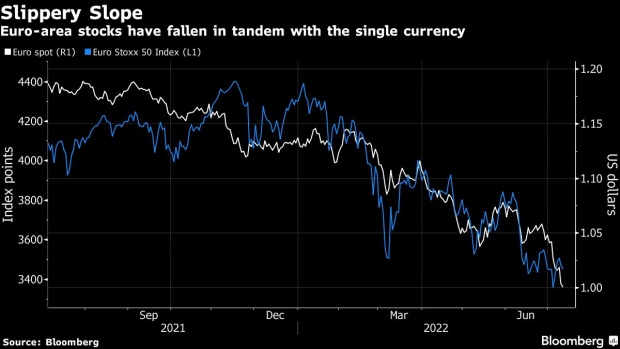Jul 13, 2022
European Stocks Dealt Fresh Blow as Euro Slips to Dollar Parity
, Bloomberg News

(Bloomberg) -- Just as European investors thought the outlook for the region’s equities couldn’t get much bleaker, the euro has declined to reach parity with the dollar for the first time in two decades.
The single currency extended declines to trade at par with the dollar on Wednesday with the greenback strengthening on the back of hotter-than-expected US inflation data. The Stoxx 600 Index fell as much as 1.9% before trading 1.6% lower by 1:52 p.m. in London.
While a weaker euro should technically be good news for export-oriented companies, the plunge adds to headwinds for European stock investors already grappling with slowing economic growth, soaring inflation and a spiraling energy crisis. The benchmark Stoxx Europe 600 Index just wrapped up its worst first-half plunge since 2008 and strategists have warned of more declines ahead.
“The majority of European exporters are cyclical, which are still likely to struggle with recessionary headwinds,” said Marija Veitmane, senior strategist at State Street Global Markets. “Within defensives, it is pharmaceuticals that have the highest proportion of foreign sales, so that could be a good way to play currency weakness.”
Bank stocks are likely to see a big impact, since the common currency is a barometer of the state of the euro zone economy, while a weaker euro amid recession fears may dim the chances of higher interest rates lenders need to boost their margins.
The sustained decline in the euro has already hurt shares of companies focused on the euro zone more than those who have a higher dollar exposure. A Goldman Sachs basket of European shares with high dollar exposure has fallen about 9% this year, strongly outperforming a domestic-basket equivalent, which is down nearly 17%.
©2022 Bloomberg L.P.






